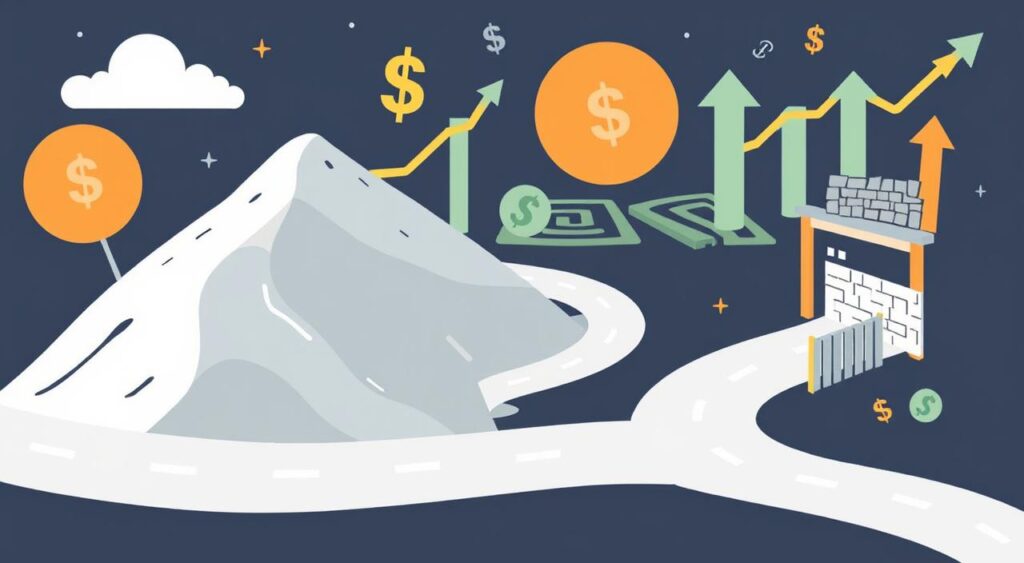Imagine sipping coffee on a sunny balcony, laptop open, and watching your bank account grow. You’re in your pajamas, but it’s real for those who know about passive income and side hustles. Financial freedom isn’t just about a 9-to-5 job. It’s about building wealth with multiple income streams and part-time work.
Think about making an online course that makes hundreds of thousands while you sleep. Or having a rental property that pays for itself and adds to your wallet each month. These are real ways people build wealth.
There are many ways to earn passive income, like dividend stocks or crowdfunded real estate. Real estate has made more millionaires and billionaires than any other strategy. YouTube’s 2.7 billion users watch over a billion hours of videos daily, creating big opportunities for content creators.
But passive income isn’t easy money. It takes time, skills, or capital upfront. The trick is to find a balance between your job and side hustles. This way, you can earn more without getting too tired.
Key Takeaways
- Passive income requires initial effort but can lead to long-term financial freedom
- Real estate investments, including REITs, are powerful wealth-building tools
- Digital products like online courses can generate substantial passive income
- Side hustles can complement passive income strategies
- Diversifying income streams helps maximize earnings and reduce risk
- Understanding tax implications is key for passive income earners
Understanding Passive Income and Side Hustles

Passive income ideas are becoming more popular in the gig economy. Many people want financial freedom by diversifying their income. Let’s look at passive income and side hustles to increase your earnings.
Defining Passive Income
Passive income is money that doesn’t need much work to keep coming in. It usually needs some effort or investment upfront. One person started earning in her 30s:
“I now earn $10,000 or more monthly from four passive income streams. It took about nine months to start making consistent passive income.”
Active vs Passive Income
Active income comes from regular jobs, while passive income requires less effort. Side hustles often start as active jobs but can become passive. About 45% of Americans have a side hustle, making an average of $688 monthly.
Common Misconceptions
Many think passive income is easy money or risk-free. But, it needs initial time and effort. The person interviewed worked 8-10 hours weekly to develop skills, then 20-30 hours for product creation. Now, she only spends 15 minutes daily on passive income projects.
Residual income from passive streams can lead to financial freedom. But, success often takes patience and planning. Diversifying income sources helps spread risk and increase chances of consistent returns.
Investment-Based Passive Income Strategies
Building wealth through passive income needs smart investment plans. Dividend stocks are a top pick. They give investors a share of company profits regularly. For instance, Coca-Cola paid $0.48 per share in 2024.
Index funds and ETFs offer a mix of dividend stocks. They spread out the risk by investing in many companies. Bonds are another way to earn passive income. By lending to companies or governments, you get interest.
Money market funds invest in safe securities, giving good interest rates. In 2023, high-yield savings and CDs offered 3-5% before the Federal Reserve rate hike. These funds can be a solid part of your portfolio.
“Investing in dividend-paying stocks offers regular income.”
Mixing these investment strategies can create a steady passive income. Here’s a quick look at what you could earn:
- Dividend stocks: Over $2,000 per month from companies like Target, Chevron, AT&T, and Proctor and Gamble
- Real estate investments: Steady income through platforms like Airbnb and Vrbo
- High-yield savings: Between 3-5% annual return
Remember, spreading your investments can balance risk and returns. Start small, learn as you go, and adjust your strategy as needed. This will help you maximize your passive income.
Real Estate as a Passive Income Generator

Real estate investing is a great way to make money without working too hard. It lets you build wealth over time with little effort. There are three main ways to make money from real estate, each with its own benefits.
Rental Properties
Buying rental properties is a classic choice for passive income. They can bring in steady money in good markets. With good management, you can make $1,000 to $2,500 a month from each property.
Short-term rentals, like those on Airbnb, can make $100 to $300 a day. This is a quick way to earn money.
Real Estate Investment Trusts (REITs)
REITs let you invest in real estate without owning properties. These companies own or finance income-generating properties. You can buy REIT shares like stocks and get dividends from their profits.
This method needs less money and doesn’t require managing properties yourself.
Crowdfunded Real Estate
Crowdfunding has changed real estate investing. It lets people invest in big projects with small amounts, starting at $500. This way, you can get into commercial real estate without needing a lot of money.
It’s a smart way to diversify your real estate investments without the hassle of owning properties.
“Real estate investing remains one of the oldest ways to build long-term passive wealth.”
Each method has its own level of effort, risk, and reward. Knowing these options helps investors pick the best fit for their goals and resources in real estate.
Digital Products and Online Ventures
The digital world is full of chances for online businesses and e-commerce. With over 5 billion people online, the opportunities are huge. In 2023, global e-commerce sales hit $5 trillion, showing how online shopping is on the rise.
Digital nomads and new entrepreneurs can dive into this market in many ways. Blogging, affiliate marketing, and dropshipping are great for starting small. They can grow and even make money without much work.
Another good idea is to sell digital products. E-books, online courses, and software can make a lot of money. For example, online course creators can make $10,000 a year, as Podia reports.
Freelance writing and virtual assistance are also good side jobs for working from home. Programmers and coders can make $20 to $150 an hour, based on their skills and the project. These jobs are in demand in many fields.
But, the digital market has its challenges. It can be crowded and needs good marketing. To succeed, you need skills, hard work, and the ability to keep up with digital trends.
Passive Income and Side Hustles

Exploring passive income and side hustles can lead to financial growth. It’s a chance to diversify your income. Let’s look at part-time businesses and remote work that can increase your earnings.
Identifying Profitable Side Hustle Opportunities
Finding the right side hustle is key. It should match your skills and what people want. Freelancing platforms provide many remote work chances in different fields. With 40% of Americans engaging in side hustles, it’s clear they’re becoming more popular.
- Online tutoring through platforms like Wyzant.com
- Selling digital products on Etsy
- Renting out unused space via Neighbor
Turning a Side Hustle into a Passive Income Stream
To make your side gig passive, plan and automate it. E-commerce sites like Shopify let you start dropshipping with little money. Selling online courses can also bring in steady money, with some bloggers making $5,000 to $100,000 a month.
Balancing Side Hustles with Full-Time Work
Managing your time well is key when working a side hustle and a full-time job. Side hustlers often work over 13 hours a week. To avoid burnout, focus on what’s important and use tools to automate tasks. The goal is to create a strategy that supports your main job.
“The secret of getting ahead is getting started.” – Mark Twain
By exploring these options and managing your time, you can boost your financial stability. This will help you reach your long-term goals.
Maximizing Earnings Through Multiple Income Streams
Income diversification is a smart way to plan your finances and manage risks. It involves using different sources of passive income to build a strong financial base. This method not only increases your income but also protects you from market ups and downs.
Starting with investment-based income is a common first step. Real estate, for instance, can be very profitable. Rental properties can earn 3-6% each year, and REITs offer dividends of 4.9%. Dividend stocks also provide good returns, with yields between 3% and 6%.
Digital products are another great way to grow your income. Online tutoring can earn you $20-$40 per hour. The print-on-demand market, worth over $10 billion, grows by 12% each year. These options allow you to make more money without working harder.
- Choose diverse income sources
- Reinvest earnings to accelerate growth
- Regularly assess and rebalance your portfolio
Remember, successful income diversification needs constant checking. You should regularly review how each income source is doing and adjust your plan as needed. This active approach helps keep your passive income portfolio strong for the long haul.
“Diversification is protection against ignorance. It makes little sense if you know what you are doing.” – Warren Buffett
By exploring multiple income streams, you’re not just making more money. You’re also creating a stable financial future that can handle economic challenges and build lasting wealth.
Overcoming Challenges in Passive Income Generation

Getting into passive income isn’t easy. It needs smart planning and a good risk assessment. Let’s look at some common problems and how to solve them.
Initial Time and Resource Investment
Starting a passive income stream takes a lot of effort upfront. Whether it’s making digital products or investing in real estate, you’ll spend time and money. Doing a good market analysis helps you make smart choices and avoid risks.
Maintaining and Scaling Income Streams
After you start making passive income, the work doesn’t stop. Growing your income means scaling up. This could be through automating tasks, outsourcing, or putting profits back into your business. Remember, successful earners often face obstacles before they see steady returns.
Dealing with Market Fluctuations and Competition
The business world is always changing. To stay on top, you need to be resilient and adaptable. Keep an eye on market trends and be ready to change your strategy when needed. Diversifying your income helps reduce risks and keeps your overall income steady. As passive income experts say, always learning and planning ahead is key to success.
“The key to passive income is not just creating it, but maintaining and growing it over time.”
By tackling these challenges, you’ll be ready to build a lasting passive income stream. It will help you weather market ups and downs.
Tax Considerations for Passive Income Earners
Tax planning is key for those earning passive income. Different income types have different tax rules. It’s important to know these details.
Passive income, like rental income or dividends, is taxed like regular income. But, some types might have tax breaks through deductions.
When it comes to reporting passive income, you need to use specific forms. For example, dividend income goes on Form 1099-DIV. Interest income is reported on Form 1099-INT. Rental income is documented on Schedule E.
Keeping accurate financial records is essential. It helps with correct reporting and using all available deductions.
Self-employment taxes usually don’t apply to passive income like rental income or dividends. This is a big plus for those earning passive income. But, some side jobs might be taxed as self-employment, based on their type and income.
- Rental income can benefit from depreciation deductions
- Dividend income from qualified stocks is taxed at lower capital gain rates
- Interest from high-yield savings accounts is reportable income
Knowing about these tax rules can help passive income earners plan better. It’s smart to talk to a tax expert. They can help understand passive income taxes and make sure you follow IRS rules.
Conclusion
Passive income strategies and side hustles are key to building wealth and financial freedom. More people are looking into these options, with about 36% of millennials already exploring them. This shows a growing need to earn more than just a salary.
Yet, it’s important to have realistic goals when starting these ventures. Creating lasting passive income often needs a big investment of time and money. For example, real estate can be a steady source of income, thanks to its cash flow and tax benefits.
Investing in turnkey multifamily properties is also a good option. It’s easier to get into, making it more accessible to many investors.
Success in passive income requires careful planning. You need to set clear financial goals, do your homework, and keep an eye on how things are going. As the world of passive income and side hustles changes, being flexible and adaptable is key. By using different strategies, you can build wealth over time and reach your financial goals.
FAQ
What is passive income?
Passive income is money you earn with little effort. It’s different from active income, like jobs. You need to invest time or money first, but then it keeps earning with almost no work.
What’s the difference between passive income and active income?
Active income comes from jobs or self-employment. Passive income needs an initial investment but then earns money with little effort.
What are some common misconceptions about passive income?
Many think passive income is easy money or risk-free. But, it often needs a lot of effort and investment upfront to work well.
How do side hustles relate to passive income?
Side hustles can help with passive income. They start as jobs but can turn into passive income over time. They add extra earnings and growth chances.
What are some investment-based passive income strategies?
Investment-based passive income includes dividend stocks and bonds. These give regular income through distributions or interest.
How can real estate generate passive income?
Real estate offers many ways to earn passive income. This includes rental properties and Real Estate Investment Trusts (REITs).
What are some digital products and online ventures for passive income?
Digital products and online ventures for passive income include online courses and e-books. Affiliate marketing and app development also work well.
How can I turn a side hustle into a passive income stream?
To turn a side hustle into passive income, automate and scale your work. This reduces the need for constant involvement.
How can I maximize earnings through multiple income streams?
Diversifying income sources reduces risk and boosts earnings. Mix investment-based income with digital products and real estate for a strong passive income portfolio.
What are some challenges in passive income generation?
Challenges include a big upfront investment and keeping income streams going. Market changes and competition also matter. Stay adaptable and keep learning.
What tax considerations should passive income earners keep in mind?
Passive income faces various taxes, including self-employment taxes. Keep good records and know tax deductions. A tax pro can help with strategies.












